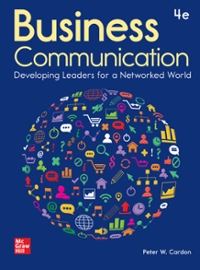A. What barriers are there to achieving shared meaning? Explain these barriers in terms of the interpersonal
Question:
A. What barriers are there to achieving shared meaning? Explain these barriers in terms of the interpersonal communication model.
B. List ten words that could easily be perceived differently.
Choose words that create semantic noise because of generational differences, occupational differences, cultural differences, or other kinds of differences.
C. Why is emotional intelligence so important in logical business tasks?
D. What are the four domains of emotional intelligence? Describe three related communication competencies for each domain.
E. What do you think are the five best strategies for developing emotional intelligence? Explain your rationale.
F. Explain how optimism and pessimism affect self-management.
G. What are some concrete examples of people using a messagecentered approach to conversations compared to people using a listening-centered approach?
H. What are some signs of a judger mentality in conversations?
How about a learner mentality?
I. The active listening process contains six steps. What steps do you think are most critical? Explain.
J. How can image of leadership be a barrier to active listening?
Provide some concrete examples.
K. Do you think fear of bad news is a common barrier to active listening among supervisors? Explain your viewpoint and provide some examples.
L. A common statement in classrooms is there’s no such thing as a bad question. In the context of the workplace, in what ways would you agree and disagree with this statement? How would you qualify this statement?
M. What is meant by perspective-getting? How does note-taking improve perspective-getting?
N. What strategies can professionals use to interpret the nonverbal communication of others? How reliable do you think interpretations of nonverbal communication can be? Explain.
O. What are the motivational value systems (MVSs) explained in this chapter? What do you view as the two most important strengths and one most significant weakness of each style?
Explain.
P. Which strategies do you think are most important for extroverts to work effectively with introverts? Which strategies do you think are most important for introverts to work effectively with extroverts? Explain.
Q. Consider the common types of incivility shown in Table 2.16.
Which five types of incivility do you think are most common?
Most serious? Name five other behaviors you view as common forms of incivility in the workplace, school, or society.
R. In what ways can gossip and complaining be uncivil? What are some ways you can constructively re-frame gossip conversations?
S. What are three things you can do to create a culture of civility and candor in the workplace? Explain.
Step by Step Answer:






